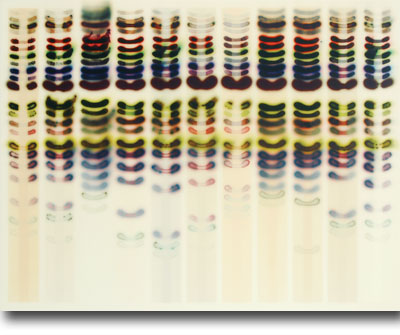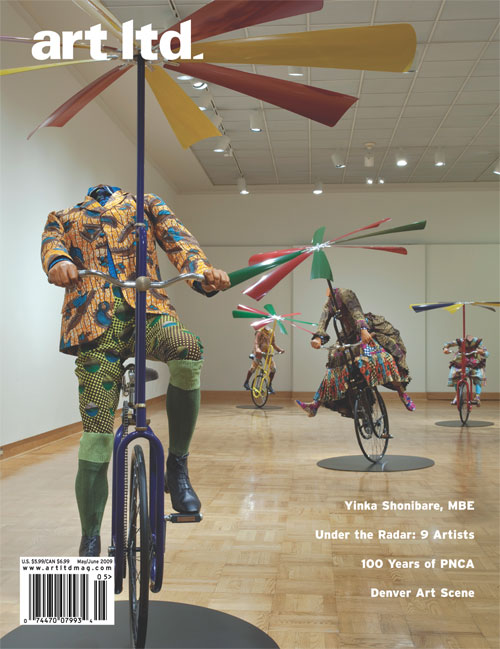Aug 2008

The question “Is it science or art?” is both redundant and moot
for Seattle-based painter Jaq Chartier. In her work, science and art merge in a
kind of mutual commentary, grounded in the artist’s exacting trials and tests.
Her compositions offer smears and stains atop off-white planes, viral-looking
shapes weeping and bubbling up in extravagant DayGlo colors: fuchsias upon acid
greens upon turquoise, blood-orange into canary yellow, flowing into each other
with fuzzy, Rothko-esque transitions. Rarely have de-facto science experiments
exuded such panache.
Chartier painted seascapes and still lifes as a
child and young adult in Palmer, Massachusetts. In college at Syracuse
University and the University of Massachusetts, she considered becoming a
filmmaker, but the siren-song of painting would not leave her. Eventually she
made her way west to Seattle, where she earned her MFA from the University of
Washington, and where she still lives. It was in 1997, while freelancing as a
technical instructor for Golden Paints, that Chartier had her “Eureka!” moment.
In the midst of preparing color and finish comparisons between various paints,
she found herself gripped by the idea of turning the tests into actual
paintings, in which she could compare and contrast, side-by-side, the
interactions between materials as they reacted to one another and to outside
forces. It was a fascination, if not an obsession, that has endured to the
present day.
As the artist continued to evolve this process, she
introduced the element of stains to her compositions—furniture and fabric dyes,
science stains, “basically any stain I could get my hands on”—and found that
when she overlaid the stains with gesso, spray paint, or acrylics, the resulting
forms resembled the gel electrophoresis slides used in genetic testing. Despite
this strong visual parity, Chartier has always maintained that the work is not
about DNA testing per se. Rather, “it’s that I’m using the creative processes in
both painting and science as metaphors for one another: for curiosity and
exploring and documenting the natural world with a sense of wonder.”
The
latest wrinkle in her approach, which she likens to an ongoing research project,
is a series called Sun Test, in which she notes the degree to which sun exposure
affects the continuing mutation of paint and stains. She’s energized by the
prospect of collectors agreeing to record the action of sunlight on their
paintings: blues gradually veering into greens, some stains slowly fading,
others brightening. It’s a fairly radical idea, turning collectors into
collaborators, but Chartier relishes the notion of interactivity between a
painting, its creator, and its owner.
Developing this series and others
keeps her busy; she averages three solo shows per year at galleries including
Elizabeth Leach (Portland, OR), Haines Gallery (San Francisco, CA), and Platform
Gallery (Seattle, WA). Along with her husband, photographer Dirk Park, she also
runs the Aqua Art Miami Fair, which the two founded in 2005 and which has since
grown in both scale and import. Juggling these and other responsibilities, the
artist says, is no easy task. “The rest of my life outside painting is basically
about getting things done in an efficient way, so that I can get back to work in
the studio.”
"Chart w/ 11 Whites," 2008, acrylic, stains, and spray
paint on wood panel, 28" x 36"
Photo: Courtesy of the artist and Elizabeth
Leach Gallery
Jaq Chartier’s solo show “Color Charts” was on view
from June 5-July 12, 2008 at Haines Gallery, in San Francisco. Her solo show
“Full Spectrum” was on view from July 3-August 2, 2008 at Elizabeth Leach
Gallery, in Portland, OR. Chartier will participate in a group show entitled
“Does DNA Define You?” at the Sun Valley Center for the Arts in Ketchum, Idaho
from August 22-October 31, 2008.

